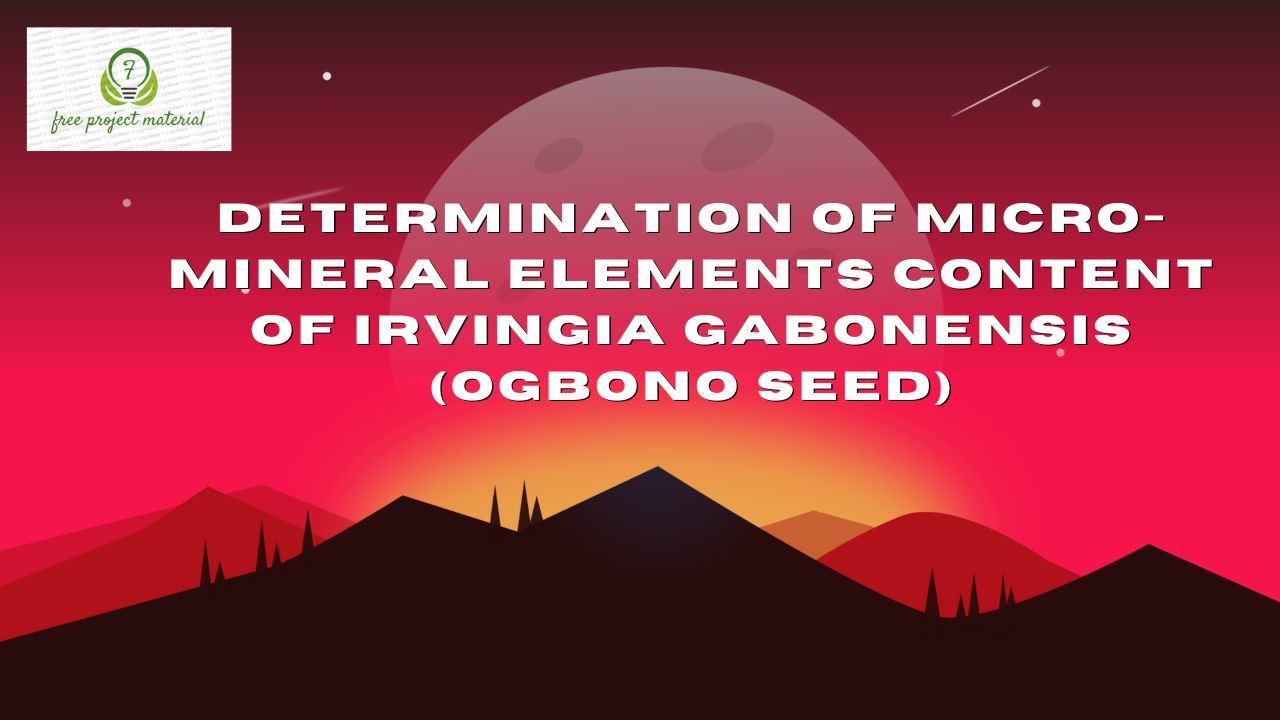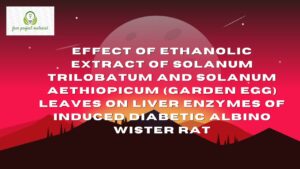ABSTRACT
This study was aimed at determining the micro- mineral composition of Irvingia gabonensis seed. The sample was obtained from the local market in Ikot Osurua. Standard analytical methods were used in carryout the analysis, the result of the study revealed the following Fe (3.104 ± 0.002mg/100g), Cu (0.722 ± 0.001 mg/100g), Mn (0.514 ± 0.014mg/100g) and Zn (0.520 ± 0.244mg/100g). this result indicate that Irvingia gabonensis seed is a poor source of micro-mineral and therefore, it is recommended that the seed should be cooked with green vegetables in order to boost the nutritional and mineral composition of the food.
TABLE OF CONTENTS
Title page- – – – – – – – – i
Certification- – – – – – – – ii
Dedication- – – – – – – – – iii
Acknowledgements- – – – – – – iv
Abstract- – – – – – – – – v
Table of contents- – – – – – – – vi
CHAPTER ONE: INTRODUCTION
1.1 Background of the Study- – – – – – 1
1.2 Aim of the study- – – – – – – – 4
1.3 Objectives of the study- – – – – – – 4
1.4 Scope and Limitation of the Study- – – – – 5
1.5 Definition of Terms- – – – – – – 5
CHAPTER TWO
LITERATURE REVIEW
2.1 Description of Irvingia gabonesis (Ogbono seed) – – 6
2.2 Botanical Classification of Irvingia gabonesis– – – 7
2.3 Origin of Irvingia gabonensis– – – – – – 7
2.4 Distribution of Irvingia gabonesis – – – – – 9
2.5 Propagation- – – – – – – – 10
2.5.1 Cultivars- – – – – – – – – 10
2.5.2 Cropping System- – – – – – – – 11
2.5.3 Nutrient Management- – – – – – – 11
2.5.4 Fruiting Age- – – – – – – – 12
2.5.5 Fruit Production- – – – – – – – 12
2.5.6 Flowering- – – – – – – – – 13
2.5.7 Harvesting- – – – – – – – – 13
2.6 Nutrition- – – – – – – – – 14
2.7 Uses of Irvingia gabonesis– – – – – – 15
2.7.1 Medicinal uses of Irvingia gabonesis– – – – – 16
2.7.2 Health Benefits of Irvingia gabonensis– – – – 16
2.7.3 Food Uses- – – – – – – – – 21
2.8 Micro minerals Elements- – – – – – 22
2.8.1 Zinc (Zn)- – – – – – – – – 23
2.8.2 Copper (Cu)- – – – – – – – 25
2.8.3 Iron (Fe)- – – – – – – – – 27
2.8.4 Manganese (Mn)- – – – – – – – 29
CHAPTER THREE: MATERIALS AND METHODS
3.1 Materials and Reagents- – – – – – – 32
3.2 Methods- – – – – – – – – 33
3.2.1 Sample collection- – – – – – – – 33
3.2.2 Sample Preparation- – – – – – – 33
3.3 Determination of micro mineral Element- – – – 34
3.3.1 Determination of Iron (Fe) content- – – – – 34
3.3.2 Determination of Copper (Cu) content- – – – 35
3.3.3 Determination of Zinc (Zn) Content- – – – – 35
3.3.4 Determination of Manganese (Mn) content- – – – 36
CHAPTER FOUR: RESULT AND DISCUSSION
4.1 Result- – – – – – – – – 37
4.2 Discussion- – – – – – – – – 38
CHAPTER FIVE: CONCLUSION AND RECOMMENDATION
5.1 Conclusion- – – – – – – – – 40
5.2 Recommendation- – – – – – – – 40
References
CHAPTER ONE
INTRODUCTION
1.1 Background of the Study
Irvingia gabonensis is an herb native to West Africa, and belongs to the Irvingiaceae family (Ross, 2011). The fleshy fruity part of the African mango is usually consumed, while the seed is also used in various types of dishes. I. gabonensis reportedly has high fiber content, and its seeds contain glycoproteins which can inhibit hydrolysis. I. gabonensis has been hypothesized to possess antidiabetic properties due to its ability to decrease fasting blood sugar levels, and has also been demonstrated to inhibit adipogenesis in vitro (Oben, Ngondi, & Blum, 2008). I. gabonensis also reportedly possesses anticholesterol properties (Tchoundjeu, & Atangana, 2007; Ross, 2011).
The body needs many minerals; these are called essential minerals. Essential minerals are sometimes divided up into major minerals (macrominerals) and trace minerals (microminerals). These two groups of minerals are equally important, but trace minerals are needed in smaller amounts than major minerals. The amounts needed in the body are not an indication of their importance. A balanced diet usually provides all of the essential minerals.
The global population is on a continuous rise, and the present 7 billion is projected to reach 9.3 billion by 2050 and surpass 10 billion by 2100 (Lee, 2011). The world’s agricultural system needs to produce more than adequate food to meet the current and future demands. Growing required amount of food alone will not solve this predicament but assuring nutritious foods, more importantly, toward a healthy living need to be the priority. Supplementation of macronutrients and micronutrients in a well-balanced proportion is indeed a global challenge. Among the macronutrients and micronutrients, the latter, though required in subtle amounts of micrograms to milligrams per day, plays a vital role on human health. Micronutrients – minerals and vitamins – aid in the normal functioning of human body as they stimulate cellular growth and metabolism by triggering a plethora of chemical reactions.
Minerals are inorganic substances, present in all body tissues and fluids and their presence is necessary for the maintenance of certain physicochemical processes which are essential to life. Minerals are chemical constituents used by the body in many ways. Although they yield no energy, they have important roles to play in many activities in the body (Eruvbetine, 2003). Every form of living matter requires these inorganic elements or minerals for their normal life processes (Ozcan, 2003).
Minerals may be broadly classified as macro (major) or micro (trace) elements. The third category is the ultra-trace elements. The macro-minerals include calcium, phosphorus, sodium and chloride, while the micro-elements include iron, copper, cobalt, potassium, magnesium, iodine, zinc, manganese, molybdenum, fluoride, chromium, selenium and sulfur (Eruvbetine, 2003). The macro-minerals are required in amounts greater than 100 mg/dl and the micro-minerals are required in amounts less than 100 mg/dl (Murray et al., 2000). The ultra-trace elements include boron, silicon, arsenic and nickel which have been found in animals and are believed to be essential for these animals. Evidence for requirements and essentialness of others like cadmium, lead, tin, lithium and vanadium is weak.
The micronutrient malnutrition, also known as hidden hunger, is often overlooked and more than one-third of the current world’s population is affected. It is a common contributor to poor growth, intellectual impairment, perinatal complications, increased risk of morbidity and mortality. This study seeks to determine the micro mineral elements content in Irvingia gobonensis.
1.2 Aim of the study
The aim of this research work is to determine the micro mineral element contents of Irvingia gabonesis (ogbono seed).
1.3 Objectives of the study
The objectives of this research project were:
- To determine the zinc (Zn) content of Irvingia gabonesis
- To determine the iron (Fe) content of Irvingia gabonesis
- To determine the copper (Cu) content of Irvingia gabonesis
- To determined the manganese (Mn) content of Irvingia gabonensis
1.4 Scope and Limitation of the Study
This research work focused on the investigation of some micro-mineral elements such as zinc, copper, iron, and manganese content of Irvingia gabonensis (Ogbono seed). Other mineral elements were not considered for analysis due to time and financial constraints.
1.5 Definition of Terms
Irvingia gabonensis (Ogbono seed): this is a genus of African and Southeast Sian tress in the family Irvingiaceae, sometimes known by the common names as, wild mango, African Mango, bush mango, dika, mbukpap uyo or Ogbono.
Micro-minerals: micro-minerals are often referred to as trace mineral elements. This means that they are present or required at low level in the body and they are also essential for food nutrients which to perform certain specific functions. Again, they are required in small amount from less than one to two hundred and fifty milligrams per day, depending on the minerals.


